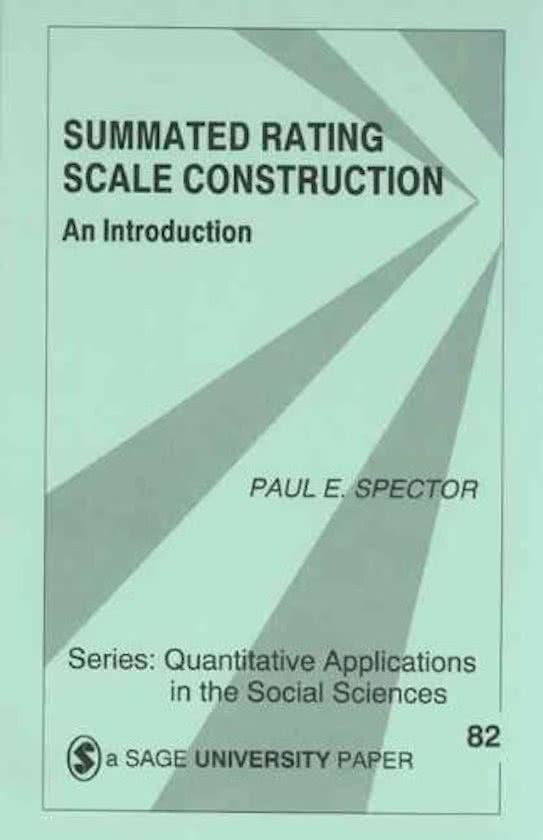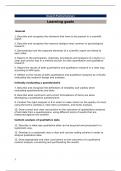Learning goals
General
1. Describe and recognize the elements that have to be present in a scientific
report.
2. Describe and recognize the research designs most common in psychological
research.
3. Demonstrate how the separate elements of a scientific report are linked to
each other.
4. Report on the participants, materials, procedures and analyses of a study in a
clear and concise way in a method section for both quantitative and qualitative
research.
5. Report the results of both quantitative and qualitative research in a clear way,
according to APA style.
6. Reflect on the results of both quantitative and qualitative analyses by critically
evaluating the research design and analyses.
Critically evaluating a questionnaire
7. Describe and recognize the definitions of reliability and validity when
evaluating questionnaires and tests.
8. Describe what constructs and correct formulations of items are when
developing a quantitative questionnaire.
9. Conduct the right analyses in R in order to make claims on the quality of a test,
using the terms Lambda-2, inter-item-correlation, and factor analysis.
10. Draw correct and clear conclusions on the outcomes of quantitative analyses
of test data from a questionnaire, using different kinds of results that are
measured against one another.
Content analysis of qualitative data
11. Describe in what way qualitative data can be acquired and processed in a
systematic way.
12. Develop in a systematic way a clear and concise coding scheme in order to
analyse qualitative data.
13. Draw appropriate and clear conclusions on the outcomes of a qualitative
content analysis, connecting and synthesizing the results.
1
, Neuroticism
Neuroticism, Extraversion, Openness, Personality Inventory Revised (NEO-PI-R). Measuring Five
Factor Model: five most important personality domains in adults. Five domains, six facets each. 48
Likert-items; 1-5 points(1= not neurotic, 5= very neurotic).
For the quantitative assignment:
* 48 Likert-items measuring neuroticism (1-5)
For qualitative assignment:
* Two additional open-ended questions (not part of NEO-PI-R)
1: Describe a situation in which you feel more neurotic than normal.
2: Describe a situation in which you feel less neurotic than normal.
Quantitative
Definition of reliability and validity
• Lambda-2, inter-item correlation, factor analysis
• Construction of questionnaires
Qualitative
Collecting and analysing qualitative data
• Developing coding schemes
• Analysing your data (Atlas.ti)
2
, General
APA rules
1. The use of passive sentences is not more academic
The passive voice is often taught as formal writing, but it inhibits clarity and makes the text
(unnecessary) longer. The passive voice can appropriately place emphasis on the thing that is
being done rather than the performer on the action. According to APA, you should use the
active voice as much as possible to create direct clear and concise sentences. Also, try to
avoid (too many) long sentences.
e.g. “The questionnaire was then completed by participants” (7
words) Versus “Participants then completed the questionnaire” (5 words)
“The research was undertaken by the authors in Spring 2022”
(10 words) Versus “We performed the research in Spring 2022” (7 words)
2. You can sometimes use the first person in science writing
Avoiding first person thought to make text appear more objective. According to APA, you
should use the first person when you’re describing the work you did as part of your research
and when you are expressing your own views. However, the first person is not always
appropriate and can make your writing look like an opinioned rant. Even if it is your subjective
position, you need to substantiate this with evidence (your data or relevant literature). A very
rough rule of thumb, the use of first person is okay in the methods and when you’re
drawing conclusions in the discussion.
3. Complexity does not always show that an authority is writing
If you want to look clever, make your writing easy to read. According to APA, a paper with
excessive jargon, contractions, unnecessary acronyms, or terminology familiar to only a few
specialists does not sufficiently contribute to the literature because its meaning is obfuscated.
APA warns against
* Ambiguity
Precision in language is hard to achieve and takes practice but is totally necessary. Avoid
overusing ‘’it’’, ‘’that’’, and ‘’they’’ and instead specifically name what you refer to.
* Wordiness
Use simple words where possible; ‘’At the present time’’ versus ‘’Now’’
* Redundancy (being excessive/unnecessary)
‘’Four different groups’’, ‘’It was previously shown’’ and ‘’The reason is because’’.
The tone in your writing should be professional, persuasive, and accessible to non-experts. Maintain
professional distance: academics don’t want your (non-evidence) based opinions. Clarity is primary,
demonstrate that YOU understand what you have written.
Three aspects of crediting sources
* Quoting and paraphrasing
* In text references
* Reference list
3
, You use APA citations to 1) substantiate (back up) your claims, 2) reflect to the scope of your work, 3)
give credit where credit is due, 4) prevent plagiarism and 5) guide readers who want to know more.
Reminders
* Headers should be in the same font, and same font size as the rest of the text
* All paragraphs should be indented in APA, except the first paragraph in an abstract
* Line spacing in APA is 2-point
* APA is the baseline - deviations are common
• Write out full words (e.g., “it is” instead of “it’s”)
Example of quoting and paraphrasing
A. Others have contradicted this view: Co-presence does not ensure intimate interaction among all
group members. (Purcell, 1997).
B. Others have contradicted this view: “Co-presence does not ensure intimate interaction among all
group members” (Purcell, 1997, p. 111).
Note
• Quotation marks
• Page number
• Be mindful of full stops
• Avoid using too many quotes – show your own understanding
Examples of in-text references
A. Kessler and John (2003) found no differences among epidemiological samples.
B. Kessler and John found no differences among epidemiological samples (2003).
Notes:
• Year always in connection with author
• Consider whether date supports your argument:
“This scale is the most widely used measure of self-esteem (Rosenthal, 1963)”
A. In a study of epidemiological samples, no differences were found (Ward, Zulik, Hutton, Hoffman,
Conway, Alison, & Halway, 1995).
B. In a study of epidemiological samples, no differences were found (Ward et al., 1995).
Notes:
• More than two authors are summarized differently in brackets
• In APA 7th this is done from very first reference (not 2 nd as in 6th)
In summary
1. Use active voice as much as possible to create direct, clear, and concise sentences. Passive
sentences are not more academic, because it inhabits clarity and makes text longer. Passive can
appropriately place emphasis on the thing that is done rather than the performer of the action.
Passive: the questionnaire was then completed by the participants.
Active: participants then completed the questionnaire.
4




